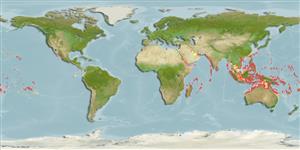Common names from other countries
Environment: milieu / climate zone / depth range / distribution range
Écologie
marin; saumâtre récifal; pH range: ? - 28.0; profondeur 1 - 40 m (Ref. 58302). Tropical; 30°N - 30°S
Indo-Pacific: Red Sea and East Africa (south to Bazaruto Island, Mozambique, Ref. 33390) to the Hawaiian, Tuamoto, and Marquesan islands, north to the Ryukyus, south to the southern Great Barrier Reef.
Taille / Poids / Âge
Maturity: Lm ? range ? - ? cm
Max length : 80.0 cm TL mâle / non sexé; (Ref. 1602)
Épines dorsales (Total): 0; Rayons mous dorsaux (Total): 0; Épines anales 0; Rayons mous anaux: 0; Vertèbres: 125 - 135. Color pale greyish brown with 16-21 dark bars; bars becoming indistinct on large individuals; top of head yellow; corner of mouth with a dark brown spot.
Found in clear waters of lagoons and seaward reefs (Ref. 9710). Benthic (Ref. 58302). Adults feed on fishes and crustaceans, mainly at night. Nervous and aggressive (Ref. 9710).
Life cycle and mating behavior
Maturité | Reproduction | Frai | Œufs | Fécondité | Larves
Chen, H.-M., K.-T. Shao and C.T. Chen, 1994. A review of the muraenid eels (Family Muraenidae) from Taiwan with descriptions of twelve new records. Zool. Stud. 33(1):44-64. (Ref. 6934)
Statut dans la liste rouge de l'IUCN (Ref. 130435)
CITES (Ref. 128078)
Not Evaluated
Menace pour l'homme
Harmless
Utilisations par l'homme
Aquarium: Commercial
Plus d'informations
Noms communsSynonymesMétabolismePrédateursÉcotoxicologieReproductionMaturitéFraiFéconditéŒufsDéveloppement de l'œuf
RéférencesAquacultureProfil d'aquacultureSouchesGénétiqueElectrophoresesHéritabilitéPathologiesTraitementMass conversion
Outils
Articles particuliers
Télécharger en XML
Sources Internet
Estimates based on models
Preferred temperature (Ref.
115969): 24.9 - 28.9, mean 27.7 (based on 670 cells).
Phylogenetic diversity index (Ref.
82804): PD
50 = 0.5000 [Uniqueness, from 0.5 = low to 2.0 = high].
Bayesian length-weight: a=0.00035 (0.00023 - 0.00052), b=3.32 (3.20 - 3.44), in cm Total Length, based on LWR estimates for this species & Genus-body shape (Ref.
93245).
Niveau trophique (Ref.
69278): 4.0 ±0.69 se; based on food items.
Résilience (Ref.
120179): Faible, temps minimum de doublement de population : 4,5 à 14 années (Preliminary K or Fecundity.).
Fishing Vulnerability (Ref.
59153): Moderate to high vulnerability (52 of 100).
